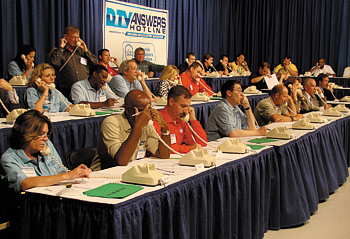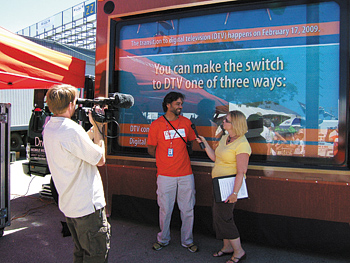Broadcasters increase participation in analog shutoff trials
LOS ANGELES The increasing number of markets performing analog shutdown trials is providing valuable information for broadcasters as they prepare for next February's transition to all-digital broadcasting. One broadcast network, in particular, was recently singled out by FCC Commissioner Jonathan Adelstein.
"Ion Media has been a leader in spearheading efforts to conduct simulated soft cut-offs in many markets across the country," Adelstein told TV Technology. "I believe these field testings and their direct impact on over-the-air viewers are extremely important in the remaining days of the national transition."

The Wisconsin Broadcasters Association sponsored a live, bilingual phone bank on during Milwaukee's Sept. 15 test. Can You See Me Now? Late last month, the West Palm Beach, Florida-based station group, along with NBC-Universal, Tele-mundo and the Association of Public Broadcasters conducted joint soft analog two-minute shutoffs in New York City, and scheduled similar one minute tests in Los Angeles and Washington, D.C. for Dec. 2. Two 30-minute tests will take place in Hartford Conn., Dec. 3. Ion broadcast partners will participate in existing tests across the country, including San Francisco (which conducted an earlier test involving 18 area stations on Oct. 21), Philadelphia and other markets. For the New York market, a consumer hotline will be operated by the Metropolitan Television Alliance, LLC.
In the midwest, the Wisconsin Broadcasters Association and member stations will conduct statewide analog shutoff simulation tests in December. This move follows simultaneous testing done by a dozen Milwaukee stations on Sept. 15.
"Wisconsin happens to be tied for the third highest percentage of over-the-air households, at 23 percent," said WBA spokesperson Michelle Vetterkind. "Each market will have a different date, and we will have a live, local phone bank for each of these markets."
Four new markets will be tested: Eau Claire-La Crosse, Green Bay-Appleton, Madison, and Wausau- Rhinelander. At least two markets are considering a Hmong hotline option in addition to the English and Spanish choices offered in the Mil-waukee test.
Milwaukee will be retested sometime between 6:00 p.m. and 7:00 p.m. versus the 60-second test done at 5:10 p.m. on Sept. 15, to better accommodate viewers' work schedules, said Vetterkind. The 3-hour phone bank will begin operations at 6 p.m.

Michelle Vetterkind, president, Wisconsin Broadcasters Association, conducts an interview during a DTV information event at the State Fair in Milwaukee.DIFFERING APPROACHES
More than 3,000 calls were answered during the Milwaukee test.
The WBA-sponsored, 46-person phone bank at WDJT-TV was manned by employees from the participating stations, cable systems and satellite providers, including engineers and general managers.
WDJT-TV, Channel 58 (Weigel Broadcast Co.); WISN-TV, Channel 12 (Hearst-Argyle Television); WITI-TV Channel 6 (Local TV LLC), and WTMJ-TV Channel 4 (Journal Broadcast Group) conducted the test during their newscasts. At 5:10, they removed the primary video signal from the analog transmitter for 60 seconds, delivering a simulated static image to analog viewers with special audio instructions to get a digital television signal. DTV-enabled viewers were informed that they were already DTV-ready.
A different approach was taken by Sinclair Broadcast Group's WCGV-TV, Channel 24 and WVTV-TV, Channel 18; Trinity Broadcasting Networks' WWRS-TV, Channel 52; WBME-TV, Channel 49 (Weigel Broadcast Co.); WPXE-TV, Channel 55 (Ion Media Networks); WVCY-TV, Channel 30 (VCY America); and public broadcasting duopoly WMVS-TV, Channel 10 and WMVT-TV, Channel 36.
"We ran a crawl on our analog [transmission], steering people toward the phone bank if they had any questions," said Kevin Kukowski, manager of engineering and operations for WMVS-TV/WMVT-TV. "A couple of [other] stations did a squeeze back—like they do for weather or school closings—running crawls in the squeeze back to drive the point home. The digital [picture] remained clear."
Kukowski oversaw his stations' initiative and, he said, served as a runner at the phone bank, answering technical questions.
"Most of the calls were from people who had gotten the converter boxes and were either having antenna problems [mostly rabbit ears] or problems with operating the box," he said. Some were using the remote control for their old TV set, thinking that the converter box literally "converted" analog channels into their digital counterparts automatically. "They had no clue that they needed to keep the TV on channel 3 or the video input, depending on how they had it hooked up."
'ROAD BLOCK'
The Nevada Broadcasters Association is planning a "road block" soft test for the entire Southern Nevada market in November, followed by a Northern Nevada test in December, according to the association's field engineer, Adrienne Abbott.
Las Vegas' KVBC conducted its own test May 2, at 10 minutes past the top of each of 10 newscasts throughout the day. The 45-second demonstration included an introduction by the show anchor in KVBC's transmission room with one hand on a plug in a patch panel—describing what would happen.
"We had a video cable going into the patch panel," said KVBC's Chief Engineer Mark Guralnik. Once the anchor pulled the plug, the station interrupted the video going to its analog studio to transmitter microwave link, but left the audio up. "We had a looping feed of simulated snow that popped up once they pulled the plug."
The anchors continued to talk over the static, giving more details about the analog shutoff, as a message was overlaid advising analog viewers to call the National Broadcasters Association's DTV Answers 800 number or link to its Web site. KVBC estimated that about two dozen calls came in.
Later this month, more than 40 Pennsylvania stations in six markets (Erie, Johnstown/Altoona, Philadelphia, Pittsburgh, Har-risburg/Lancaster/ York and Wilkes-Barre/Scranton), will conduct a similar exercise at 6:25 p.m. Those stations will either interrupt the analog feed (leaving viewers with static) or broadcast a message explaining the transition.
The professional video industry's #1 source for news, trends and product and tech information. Sign up below.
